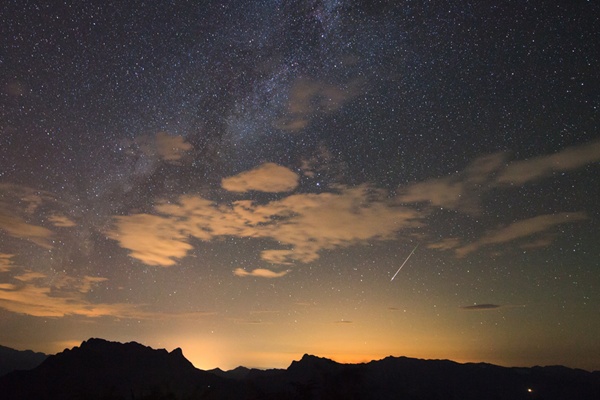The Sky This Week from August 9 to 18 – Astronomy Magazine
Perseid meteor shower
Everyone’s favorite meteor shower peaks under a moonlit sky before dawn August 13, though you might get better views the morning of the 12th. This Perseid fireball appeared above the city lights of Nanchuan in western China at the peak of the 2013 shower.
Jeff Dai
Although Jupiter reached opposition and peak visibility two months ago, it remains a stunning sight from shortly after sunset until well past midnight. But it appears especially nice this evening, when a waxing gibbous Moon passes just 2° north (upper left) of the planet. You can find the pair high in the south as darkness falls. Both objects reside among the background stars of Ophiuchus. While the Moon moves on to Sagittarius by tomorrow evening, Jupiter remains in the Serpent-bearer all week. Shining at magnitude –2.4, the giant world is the night sky’s brightest object except for the Moon. When viewed through a telescope, the planet’s disk spans 42″ and shows striking cloud-top detail.
Saturday, August 10
Mercury reached greatest western elongation yesterday, but it remains just as conspicuous before dawn all this week. This morning, the innermost planet rises 90 minutes before the Sun climbs 8° high in the east-northeast 45 minutes before sunup. The magnitude –0.1 world shines noticeably brighter than the twin stars of Gemini, Castor and Pollux, which lie higher in the sky and point in Mercury’s direction. If you have trouble spotting the planet with your naked eye, scan the area with binoculars. When viewed through a telescope, Mercury shows a disk that spans 7.4″ and appears about 40 percent lit.
Sunday, August 11
The Moon’s eastward motion relative to the background sky carries it to Saturn’s vicinity this evening. As darkness falls, the Moon appears some 4° to the planet’s right, but the gap closes as the night wears on. By the time the pair sets around 3 a.m., Luna has pulled within 2° of its companion. Saturn remains a stunning object all week, shining at magnitude 0.2 and growing more prominent as the Moon moves away. When viewed through a telescope, the planet shows an 18″-diameter disk surrounded by a spectacular ring system that spans 41″ and tilts 25° to our line of sight.
Monday, August 12
The Perseid meteor shower peaks tomorrow morning, but with Full Moon arriving in just a few days, viewing conditions are less than ideal. Luna’s bright light will drown out fainter meteors and leave the brighter ones less impressive during the prime viewing hours after midnight. Instead of seeing up to 100 meteors per hour as you might in a good year, a typical observer may see only 15 to 20 per hour. Tomorrow morning, the Moon sets less than a half-hour before twilight begins. You might have better luck viewing this morning, when the Moon sets about an hour earlier.
Tuesday, August 13
Assuming you watch the Perseid show this morning, don’t pack up when twilight starts to paint the sky. About 45 minutes before the Sun comes up, look for a bright object hovering just above the horizon in the east-southeast. This is the night sky’s brightest star, magnitude –1.5 Sirius in the constellation Canis Major. From mid-northern latitudes, the luminary climbs some 4° high a half-hour before sunrise and should stand out if you have a clear and unobstructed horizon. The return of Sirius to the predawn sky was an occasion for celebration in ancient Egypt. Around 3000 B.C., this so-called heliacal rising of Sirius heralded the coming flood of the Nile River, an event upon which agriculture — and all life in Egypt — depended.
Wednesday, August 14
Full Moon officially arrives at 8:29 a.m. EDT tomorrow morning, but it will look completely illuminated both tonight and tomorrow night. You can find it rising in the eastern sky around sunset and then watch it climb highest in the south by 1 a.m. local daylight time. It dips low in the west by the time morning twilight starts to paint the sky. The Moon lies against the backdrop of Capricornus the Sea Goat, though its bright glow nearly drowns out the faint stars in this constellation.
Venus passes on the far side of the Sun from our perspective at 2 a.m. EDT this morning. Of course, the Sun’s glare totally obscures the planet. It will return to view in the evening sky in October.






